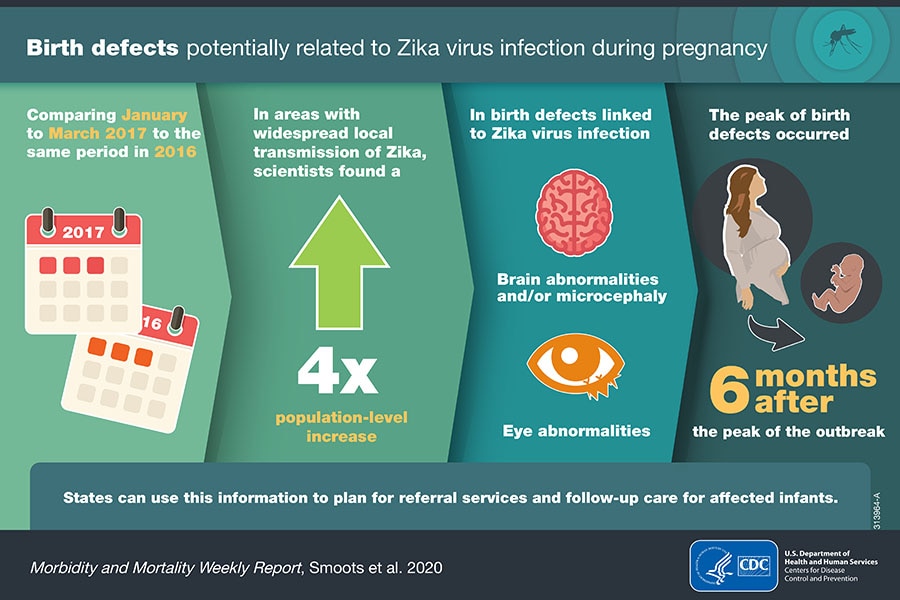Birth defects potentially related to Zika increased in U.S. territories after widespread local transmission
Scientists from the Centers for Disease Control and Prevention (CDC) published a report on birth defects and Zika virus infection (Zika). The report found a four-fold increase in the birth defects most strongly linked to Zika during pregnancy in areas with widespread local transmission.
Main Findings
Birth defects potentially related to Zika increased four-fold in two U.S. territories from January to March 2017, compared to the same time period in 2016. Both areas had widespread local spread of Zika through early 2017.
The peak of the increase in birth defects potentially related to Zika occurred in February 2017 in these areas, 6 months after the reported peak of the Zika virus outbreak.
Among births included in the report, CDC scientists found about 2 out of every 1,000 babies born had a birth defect potentially related to Zika or other factors.
- Most (84%) were born with brain abnormalities and/or microcephaly (small head size); and
- Nearly 2 in 10 (16%) had eye abnormalities without brain abnormalities.
In areas with widespread transmission, about 50% of infants tested had laboratory evidence of confirmed or possible Zika virus infection in maternal, placental, fetal, or infant specimens.
About This Study
CDC’s Zika Birth Defects Surveillance (ZBDS) was a tracking system that collected medical information to better understand Zika in pregnant women and their babies. Zika Birth Defects Surveillance followed any infant born in 2016 or 2017 with a birth defect potentially related to Zika, regardless of Zika lab testing or exposure. There were more than 2 million live births in the 22 states and territories included in this report.
Zika Birth Defects Surveillance found infants with birth defects by using standard measures. This allowed health departments across the country to collect infants’ medical information in the same way. Since Zika Birth Defects Surveillance did not require a mother or infant to have Zika lab testing, the system found infants with birth defects that other Zika tracking systems might have missed, potentially because the mothers did not have Zika symptoms or samples were not collected for Zika testing. Finding these birth defects early helps families get the services and support they need for the best care for their infants.
Public Health Tracking
During the response to the 2016–2017 Zika virus outbreak, population-based birth defects surveillance programs across the country were quickly changed to include birth defects potentially related to Zika. These programs provide more complete information on the number of infants affected and allow states to plan care for these infants by identifying and linking them to services.
These programs are collaborations with state, tribal, local, and territorial health departments. They are important for finding and helping mothers and babies affected by Zika virus. They highlight successful partnerships across public health areas, including birth defects, infectious disease, maternal and child health, and public health labs, to quickly find mothers and infants affected by Zika.
Reference
Smoots AN, Olson SM, Cragan J, et al. Population-Based Surveillance for Birth Defects Potentially Related to Zika Virus Infection — 22 States and Territories, January 2016–June 2017. MMWR Morb Mortal Wkly Rep 2020;69:67–71. DOI: http://dx.doi.org/10.15585/mmwr.mm6903a3external iconexternal icon.
